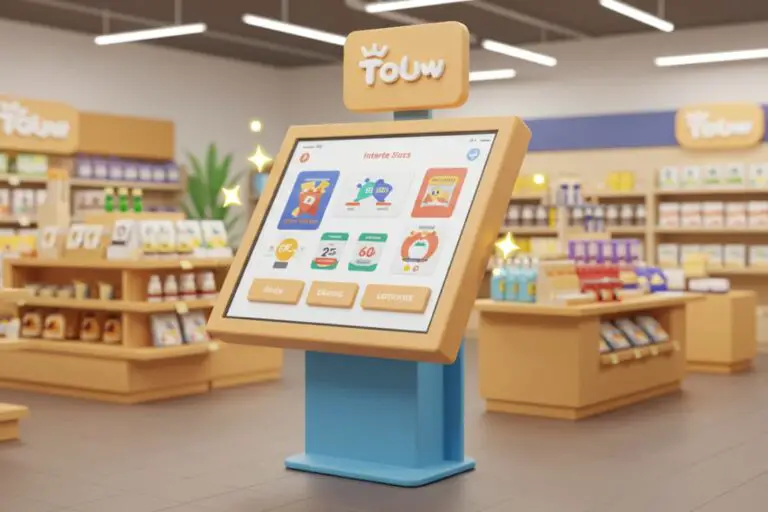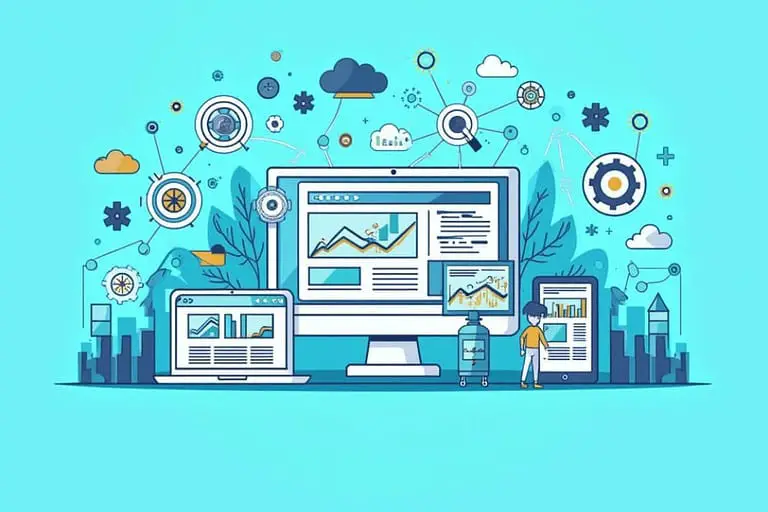Walk into a store in 2025 and it’s like magic—a perfect blend of digital convenience and physical shopping. As soon as you step inside your phone lights up with offers, like the store already knew what you’ve been looking for.
Digital displays grab your attention not just with ads but with experiences that let you explore, play and learn about the products in front of you. It’s not just shopping—it’s a journey for you, combining the latest tech with thoughtful design to make every moment fun.
In this article we’ll look at how in-store marketing strategies has changed to meet the needs of today’s shopper.
Evolution of In-Store Marketing
In-store marketing has evolved significantly. Stores once relied on static, generic signs that didn’t excite or connect with shoppers.
As technology advanced, retailers began using digital signage and personalized offers sent to shoppers’ phones.
The pandemic accelerated the use of augmented and virtual reality to provide contactless, online-like experiences in stores.
Core Elements of Modern In-Store Marketing
To thrive in the retail landscape it’s crucial to understand the core elements that define modern in-store marketing. Let’s explore each of these pillars in detail.
1. Digital Integration Strategies
One of the most significant shifts in in-store marketing is the integration of digital technologies. By incorporating interactive displays, AR/VR experiences, and mobile apps, retailers can create engaging, multi-sensory shopping journeys that captivate customers.
Consider beauty brand Sephora’s “Virtual Artist” app, which allows shoppers to try on makeup products virtually using their smartphone camera.
This digital tool not only enhances the in-store experience but also drives product discovery and sales.

2. Sensory Marketing Techniques
Sensory marketing involves leveraging sight, sound, smell, taste, and touch to create immersive in-store experiences.
By carefully curating the sensory elements of your store environment, you can evoke positive emotions, increase dwell time, and drive customer loyalty.
A prime example is Abercrombie & Fitch’s signature scent, which permeates their stores and has become synonymous with the brand.
The fragrance not only creates a pleasant atmosphere but also triggers memories and associations, encouraging shoppers to linger and make purchases.
3. Personalization Approaches
In the era of big data and advanced analytics, personalization has become a game-changer in in-store marketing. By leveraging customer data, such as purchase history and browsing behavior, retailers can tailor offerings, recommendations, and promotions to individual shoppers.
Nordstrom’s ‘Reserve Online, Try In-Store’ service exemplifies the power of personalization, allowing customers to handpick items online that are ready for them to try on in-store, complete with tailored recommendations from stylists based on their preferences
4. Interactive Technology Solutions
Interactive technologies, such as touchscreens, gesture-based controls, and voice assistants, are transforming the way shoppers engage with products in-store.
These solutions not only provide entertainment but also enable customers to access detailed product information, compare options, and make informed purchase decisions.
Nike’s flagship store in New York City features an entire floor dedicated to interactive experiences. Shoppers can design their own sneakers, test them on a treadmill, and get real-time performance feedback—all powered by cutting-edge technology.
5. Data-Driven Decision Making
Data is the lifeblood of modern in-store marketing. By collecting and analyzing customer data from various touchpoints, retailers can gain valuable insights into shopper behavior, preferences, and pain points.
Target’s “Guest ID” program is a prime example of data-driven decision making. By assigning each shopper a unique identifier, Target can track their behavior across channels and use that data to optimize in-store experiences, from personalized promotions to targeted product recommendations.
These insights can then inform strategic decisions, from product assortment to store layout and beyond.
Advanced In-Store Marketing Strategies
Now that we’ve explored the core elements of modern in-store marketing, let’s dive into some advanced strategies that are set to define the retail landscape of 2025.
1. AI and Machine Learning Applications
Artificial intelligence (AI) and machine learning (ML) are transforming in-store marketing by automating and optimizing shopping experiences, including product recommendations and inventory management.
For instance, Lowe’s utilizes AI through its ‘LoweBot,’ which assists customers by providing product information and monitoring inventory levels.
2. Augmented Reality Experiences
AR is blurring the lines between the digital and physical worlds, allowing shoppers to interact with products in entirely new ways.
By overlaying digital information onto the real world, AR enables customers to visualize how products will look in their homes, try on clothing virtually, and access detailed product information.
Ikea’s “Place” app is a shining example of AR’s potential. Using a smartphone camera, shoppers can see how Ikea furniture will look in their space before making a purchase, reducing the guesswork and increasing conversion rates.

3. Smart Shelf Technology
Smart shelves are revolutionizing the way retailers track inventory and interact with customers in-store.
Equipped with sensors, cameras, and digital displays, smart shelves can monitor stock levels, detect when items are misplaced, and even push targeted promotions to shoppers’ smartphones based on their location in the store.
Kroger’s “EDGE” (Enhanced Display for Grocery Environment) technology is a leading example of smart shelves in action.
These digital shelf-edge displays can dynamically adjust prices, highlight promotions, and even offer personalized recommendations based on a shopper’s purchase history.
4. Mobile Integration Techniques
Mobile devices have become an integral part of the in-store shopping experience.
By leveraging mobile apps, push notifications, and location-based services, retailers can engage with customers at every step of their journey, from product discovery to checkout.
Starbucks’ mobile app is a prime example of seamless mobile integration. Customers can order and pay for their drinks in advance, skip the line, and earn rewards—all from their smartphone.
The app also pushes personalized offers based on location and purchase history, driving loyalty and repeat visits.
5. Interactive Displays and Kiosks
Interactive displays and kiosks are transforming the way shoppers engage with products in-store.
These self-service solutions allow customers to access detailed product information, compare options, and even complete transactions without the need for staff assistance.
Sephora’s “Beauty Hub” is a standout example of interactive displays in action. These in-store kiosks allow shoppers to virtually try on makeup, get personalized recommendations, and even access tutorials and product reviews—all with a few taps on a screen.
Customer Journey Optimization
To maximize the impact of in-store marketing, it’s essential to optimize every touchpoint along the customer journey. Let’s explore some key strategies for each stage.

1. Entry Point Engagement
The moment a customer enters your store is a critical opportunity to make a strong first impression. By leveraging digital signage, interactive displays, and personalized greetings, you can immediately engage shoppers and set the tone for their entire visit.
London Drugs, a Canadian pharmacy chain, uses digital signage at the entrance to highlight current promotions and guide shoppers to key departments.
These dynamic displays not only grab attention but also streamline the shopping experience.
2. In-Aisle Experiences
The in-aisle experience is where the magic of product discovery and engagement happens.
By incorporating interactive elements, such as AR product visualizations and smart shelf technology, you can transform the traditional browsing experience into an immersive, personalized journey.
Walgreens’ “Aisle411” app is a prime example of in-aisle optimization. Using a smartphone camera, shoppers can access product information, reviews, and even coupons by simply scanning the shelf.
This not only enhances the shopping experience but also drives sales and loyalty.
3. Point-of-Purchase Optimization
The checkout process is a critical moment in the customer journey. By streamlining the transaction and incorporating personalized offers, you can increase basket size and drive customer satisfaction.
Amazon Go’s “Just Walk Out” technology is a game-changer in point-of-purchase optimization. Using a combination of computer vision, sensors, and AI, the store allows shoppers to simply grab what they need and go, with the transaction automatically charged to their Amazon account.
This frictionless experience not only saves time but also eliminates common pain points, such as long lines and cash handling.
4. Post-Purchase Engagement
The customer journey doesn’t end at the point of purchase. By continuing to engage with shoppers after they leave the store, you can foster loyalty, drive repeat visits, and even turn customers into brand advocates.
Sephora’s “Beauty Insider” program is a standout example of post-purchase engagement.
Members earn points for every purchase, which can be redeemed for exclusive rewards and experiences. The program also includes personalized recommendations, early access to new products, and even invitations to in-store events.
Measuring In-Store Marketing Success
To continually optimize your in-store marketing efforts, it’s crucial to have a robust measurement framework in place. Let’s explore some key metrics and techniques for gauging success.

1. Key Performance Indicators (KPIs)
KPIs are quantifiable measures that help you track progress toward your in-store marketing goals. Some common KPIs include:
- Sales per square foot
- Average transaction value
- Customer dwell time
- Conversion rate
- Net Promoter Score (NPS)
By regularly monitoring these metrics, you can identify areas of strength and opportunity, and make data-driven decisions to optimize your in-store marketing strategies.
2. ROI Calculation Methods
To justify investment in in-store marketing initiatives, it’s essential to demonstrate a clear return on investment (ROI). Some common methods for calculating ROI include:
- A/B testing: Comparing the performance of different in-store marketing tactics to determine which drives the highest return
- Incremental sales lift: Measuring the incremental sales generated by a specific in-store marketing campaign
- Customer lifetime value (CLV): Calculating the total value a customer brings to your business over their entire relationship with your brand
By using a combination of these methods, you can build a compelling case for in-store marketing investment and secure the necessary resources to drive innovation and growth.
3. Customer Behavior Analytics
Customer behavior analytics involve tracking and analyzing how shoppers interact with your store environment, products, and marketing touchpoints.
By leveraging tools such as video analytics, heat mapping, and beacon technology, you can gain valuable insights into:
- Traffic flow and dwell time
- Product engagement and interaction
- Display effectiveness
- Promotion response rates
These insights can then inform optimizations to your store layout, product placement, and marketing tactics, driving continuous improvement in the customer experience.
Implementation Guide
Now that we’ve explored the strategies and metrics for successful in-store marketing, let’s dive into the practical steps for implementation.

1. Budget Planning
The first step in any in-store marketing initiative is to establish a clear budget. Consider factors such as:
- Technology investments (e.g. digital signage, interactive displays, sensors)
- Content creation and management
- Training and staffing
- Maintenance and updates
By carefully planning your budget upfront, you can ensure that your in-store marketing efforts are both impactful and sustainable over the long term.
2. Technology Selection
With so many in-store marketing technologies available, it’s essential to select the solutions that best fit your unique needs and goals. Consider factors such as:
- Integration with existing systems
- Scalability and flexibility
- User experience and adoption
- Vendor support and reliability
By thoroughly evaluating your options and selecting the right technology partners, you can set your in-store marketing initiatives up for success.
3. Staff Training Requirements
Your store associates are the face of your brand and the key to bringing your in-store marketing vision to life. To ensure a seamless execution, it’s crucial to invest in comprehensive training that covers:
- Technology usage and troubleshooting
- Customer engagement techniques
- Brand messaging and values
- Feedback and optimization processes
By empowering your staff with the skills and knowledge they need to excel, you can create a cohesive, customer-centric experience that drives results.
4. Timeline Development
To keep your in-store marketing initiatives on track, it’s essential to develop a clear timeline that outlines key milestones and dependencies. Consider factors such as:
- Technology procurement and installation
- Content creation and testing
- Staff training and onboarding
- Launch and post-launch optimization
By breaking your implementation plan into manageable phases and assigning clear ownership and deadlines, you can ensure a smooth rollout and ongoing success.
5. Risk Management
As with any new initiative, in-store marketing comes with its share of risks and challenges. To mitigate potential issues, it’s important to proactively identify and address risks such as:
- Technology malfunctions or outages
- Data privacy and security concerns
- Customer adoption and feedback
- Competitive threats and market shifts
By developing contingency plans and regularly monitoring for potential risks, you can stay ahead of the curve and adapt your in-store marketing strategies as needed.
Case Studies
To bring the power of in-store marketing to life, let’s explore some real-world success stories from leading retailers.
1. Nike’s House of Innovation
Nike’s House of Innovation flagship stores in New York City and Shanghai showcase the brand’s cutting-edge approach to in-store marketing. The stores feature interactive experiences such as:
- Customization studios where shoppers can design their own sneakers
- Treadmills and basketball courts for product testing
- AR-powered displays that allow customers to see how different colors and materials look on a shoe
By creating immersive, hands-on experiences, Nike not only drives engagement and sales but also builds lasting emotional connections with customers.
2. Sephora’s Beauty TIP Workshop
Sephora’s Beauty TIP (Teach, Inspire, Play) Workshop is a standout example of experiential in-store marketing. The workshop features:
- Interactive makeup stations where customers can try on products and get personalized recommendations
- Virtual try-on technology that allows shoppers to see how different shades and styles look on their face
- Tutorials and classes led by beauty experts
By creating a fun, educational environment, Sephora not only drives product discovery and sales but also positions itself as a trusted beauty authority.
3. Lowe’s “In-Store Navigation” App
Lowe’s “In-Store Navigation” app is a prime example of mobile integration in the in-store experience. The app features:
- Turn-by-turn directions to help shoppers find specific products in the store
- Augmented reality functionality that allows customers to see how products will look in their home
- Personalized promotions and recommendations based on purchase history and location
By leveraging mobile technology to enhance the in-store experience, Lowe’s not only makes shopping more convenient but also drives loyalty and repeat visits.
Future Trends in In-Store Marketing
As we look ahead to the future of in-store marketing, several exciting trends are poised to shape the retail landscape.

1. Personalization at Scale
With advances in AI and machine learning, retailers will be able to deliver hyper-personalized experiences to every shopper, at every touchpoint.
From dynamic digital signage that adapts to individual preferences to VR experiences that allow customers to “try before they buy,” personalization will become the norm rather than the exception.
2. Seamless Online-to-Offline Integration
As the lines between online and offline shopping continue to blur, retailers will need to create seamless experiences that allow customers to move effortlessly between channels. This may include features such as:
- In-store pick-up and returns for online orders
- Mobile apps that allow shoppers to scan and purchase products in-store
- Personalized recommendations that span online and offline interactions
By creating a unified commerce experience, retailers can drive convenience, loyalty, and ultimately, sales.
3. Sustainability and Social Responsibility
As consumers become increasingly conscious of the environmental and social impact of their purchases, retailers will need to prioritize sustainability and social responsibility in their in-store marketing efforts. This may include:
- Eco-friendly displays and packaging
- Promotions that support social and environmental causes
- In-store education and engagement around sustainability initiatives
By aligning their in-store marketing strategies with their values, retailers can build deeper, more meaningful relationships with shoppers and drive long-term brand loyalty.
4. Immersive Technologies
As technologies like augmented reality (AR), virtual reality (VR), and 3D modeling continue to advance, retailers will have new opportunities to create truly immersive in-store experiences.
Imagine being able to “step inside” a virtual home and see how different furniture pieces look and feel, or using AR to visualize how an outfit will look on you without ever trying it on.
These immersive technologies will blur the lines between the physical and digital worlds, creating engaging experiences that drive product discovery and sales.
For example, home improvement retailer Lowe’s has already experimented with VR experiences that allow shoppers to design and visualize their dream kitchen or bathroom.
By providing a realistic, interactive preview of how products will look in their space, Lowe’s is helping customers make more informed purchase decisions and driving higher customer satisfaction.
5. Data-Driven Optimization
As in-store marketing becomes increasingly digitized, retailers will have access to a wealth of real-time data on customer behavior, preferences, and engagement.
By leveraging advanced analytics and machine learning, retailers can continuously optimize their in-store marketing strategies based on what’s working and what’s not. This may include:
- A/B testing different display configurations or messaging to see what drives the highest engagement
- Predictive analytics to anticipate customer needs and preferences based on past behavior
- Real-time inventory optimization based on demand signals from in-store sensors and smart shelves
By embracing a data-driven approach to in-store marketing, retailers can create more targeted, effective experiences that drive measurable business results.
Practical Tips and Best Practices
To help you get started with in-store marketing optimization, here are some practical tips and best practices to keep in mind:
1. Start with the Customer
Before investing in any new in-store marketing technology or tactic, take the time to understand your customers’ needs, preferences, and pain points.
Conduct customer research, analyze purchase data, and gather feedback from store associates to gain a deep understanding of what your customers want from the in-store experience.
Use these insights to guide your in-store marketing strategy and prioritize initiatives that will have the greatest impact on customer satisfaction and loyalty.
2. Focus on Seamless Execution
While in-store marketing technologies can be powerful tools for engagement and conversion, they’re only effective if they’re executed seamlessly.
Make sure to thoroughly test and refine any new in-store marketing initiatives before rolling them out to ensure a smooth, bug-free experience for shoppers.
Train your store associates on how to use and troubleshoot new technologies, and have clear processes in place for handling any issues that may arise.
3. Measure, Learn, and Iterate
In-store marketing optimization is an ongoing process, not a one-time event. Continuously measure the performance of your in-store marketing initiatives using the KPIs and ROI calculation methods outlined earlier.
Use these insights to identify areas for improvement and experiment with new tactics and technologies. Embrace a culture of continuous learning and iteration, and be willing to pivot your strategy based on what the data tells you.
4. Collaborate Across Channels
In-store marketing doesn’t exist in a vacuum. To create a truly seamless, cohesive customer experience, it’s essential to collaborate closely with your digital marketing, e-commerce, and customer service teams.
Break down silos and ensure that your in-store marketing efforts are integrated with your broader omnichannel strategy. This may include tactics like:
- Using in-store digital signage to highlight online promotions and vice versa
- Enabling store associates to access customer data and purchase history from online interactions
- Creating consistent messaging and branding across all touchpoints
By taking a holistic, cross-functional approach to in-store marketing, you can create a more seamless, personalized experience that drives loyalty and lifetime value.
The world of in-store marketing is evolving at a breakneck pace, but by embracing the strategies, technologies, and best practices outlined in this article, retailers can thrive in the face of disruption and emerge as leaders in the new era of retail.
The key is to stay agile, adaptable, and always put the customer first. With the right mindset and approach, the future of in-store marketing is bright indeed.




